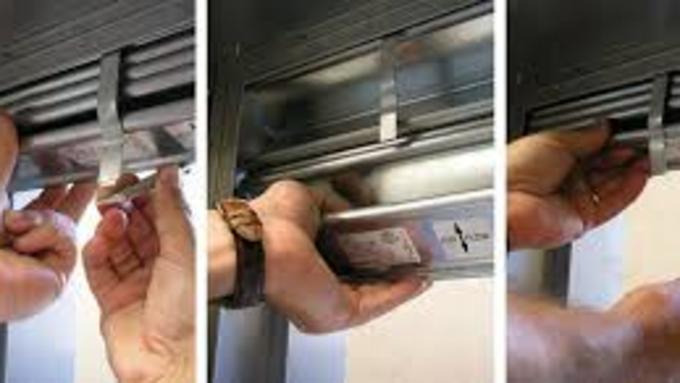Fire and Smoke Damper Testing
19th January 2019
Fire and Smoke Damper Testing and Inspection
What Are Fire Dampers?
Fire and smoke dampers are fitted in ductwork where it passes through a fire compartment barrier, for example at fire-rated walls and floors. They are designed to shut when a specified temperature or fire/smoke condition is met, preventing the spread of fire and smoke.
How Do Fire Dampers Work?
In the most common design, a fusible link holds a spring-loaded shutter open. When the temperature (typically 72° C) is reached the link ‘fuses’, or melts and the shutter drops to stop the passage of hot air and smoke. Many other designs are also employed.
Why Test And Inspect Fire And Smoke Dampers?
Fire dampers play a crucial role in a building’s fire safety system. If they don’t operate as designed fire can spread with rapid, lethal results. Headline incidents involving considerable loss of life include the MGM Grand Hotel, Las Vegas & the Dusseldorf Airport fire.
The difference between a well-maintained, working fire damper and an ill-maintained, partially working fire damper can be the difference between life and death in the case of a fire.
To find out how Crystal Surafce can help you manage your fire damper inspections, request your free, no obligation, consultation now.
Why Do Fire Or Smoke Dampers Fail?
There are many reasons why a fire or smoke damper could fail, we have seen over 20% failure rates on some sites in Leeds.
Typical problems include blockages and obstructions, dirt and debris impeding a tight seal, corrosion and broken springs, poor installation or simply inadequate access to enable servicing to be carried out regularly.
It can take only one faulty damper to allow catastrophic spread of fire and smoke.
That’s why it’s important to ensure that these vital safety systems do actually operate as expected; and that’s why it’s a legal requirement to do so in the UK.
What Is The Law On Fire And Smoke Dampers?
The Regulatory Reform (Fire Safety) Order 2005 places a duty of care on the building owner/occupier to take such general fire precautions as will ensure, so far as reasonably practical, the safety of the building and safety of the people within it. Section 17 of this Order deals with maintenance of systems to control the fire risk and requires that they are subject to a suitable system of maintenance and are maintained in an efficient state, in efficient working order and in good repair.
British Standards give a good definition of ‘suitable system’. British Standard 9999:2017 Annex W.1 gives clear guidance that all fire dampers should be tested at regular intervals not exceeding 2 years and that spring operated fire dampers should be tested every 12 months and at greater frequencies if in a dust-laden environment.
All fire and smoke dampers within your building(s) should be located, serviced and tested. Then a schedule created for regular checks to ensure their continued safe operation.
Crystal Surface can help you manage your fire damper inspections in Leeds. To get started simply request your free, no obligation, consultation now.
How Often Should Dampers Be Tested?
This can be confusing since the British Standard calls for regular testing ‘not exceeding 2 years’. It does however go on to require that spring-operated fire dampers – which are the most common – should be tested every 12 months.
Environment factors play a part in how often you should test too. For example, a dusty environment will require more frequent checks and cleaning.
Hospital engineers should be aware that Health Technical Memorandum 03-01: ‘Specialised ventilation for healthcare premises Part B: Operational management and performance verification’ calls for all fire dampers to be tested annually.
If you are unsure how frequently your fire dampers should be tested, ask an expert. Our team are here to answer any queries you may have.
What Happens During A Fire Damper Inspection?
Our experts will help you achieve peace of mind by:
Creating an inventory of fire dampers in your building
Physically dropping the damper to demonstrate its effectiveness
Cleaning channels and runners, applying (light) lubrication where necessary
Addressing running repairs, for example, replacing broken fusible links
Resetting the damper
Providing you with a comprehensive report including location records, and detailed exception reports in cases of failure, with recommendations where necessary.
The important point is that ticking a box to say that a fire damper exists is not compliance that will stand up in case of a problem. It must be physically tested, cleaned and re-set.
Fire Damper Testing Summary
The latest version BS 9999:2017 is a code of practice for fire safety in the design, management and use of buildings
It states that all fire dampers should meet the criteria of fire resistance for a stated period of time
It states that any defects are to be logged, necessary action taken and certificates of testing are to be obtained
Unless you have certification to prove that you can safely carry out fire damper drop testing, you will need specialist help, choosing a BESA member is a good start
BESA member should be able to provide a complete tailored service, including the surveys and setting up the right inspection schedules and record keeping procedures, as well seamlessly installing any extra inspection hatches as needed.
About Crystal Surface Leeds (Damper Testing Leeds and Duct Cleaning Leeds)
Our ductwork specialists are highly experienced in the maintenance of critical fire safety systems in ductwork. We understand you need to provide a safe working environment for your colleagues and visitors as well as keeping suitable compliance records. We can help you with all of this and more.
We are trusted by NHS and private hospitals, commercial offices, residential dwellings, educational establishments, military and institutional building managers to install, maintain and repair their fire and smoke dampers.
Talk to an expert today, for free, no obligation advice on how to locate, maintain, repair or install fire dampers.
<< Back to Case Studies

